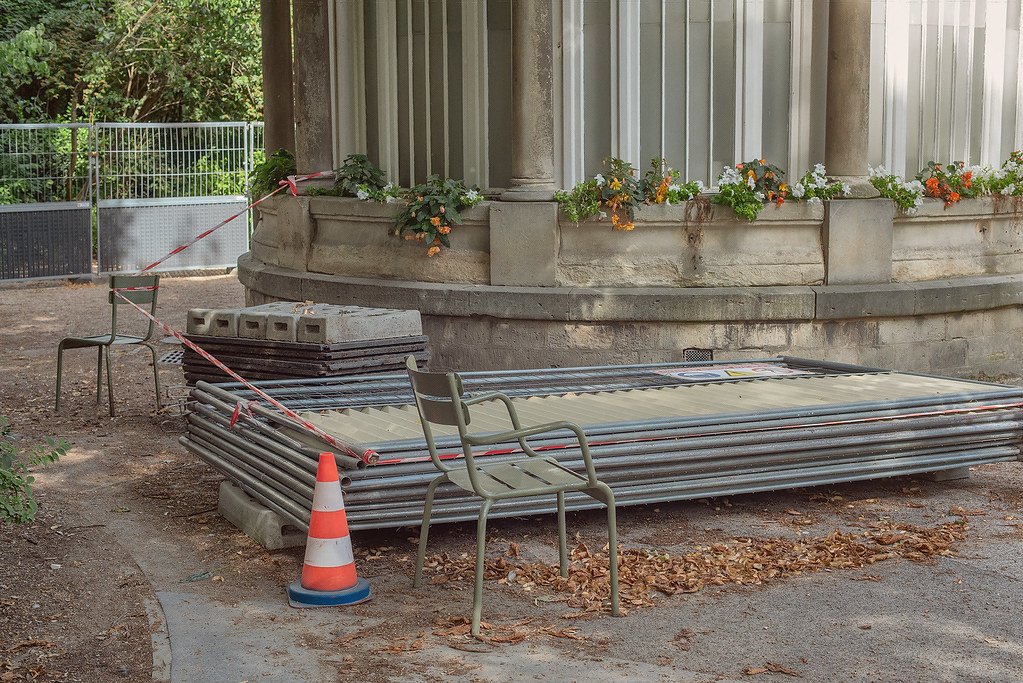#Davioud
Photo


Le "Kiosque Romantique" et sa grotte artificielle créés par l'architecte Gabriel Davioud (circa 1860) - inspiré du "Temple de Vesta" situé à Tivoli près de Rome en Italie tout comme sa réplique quasi identique dite du « Temple de la Sybille » sur l'Île du Belvédère dans le parc des Buttes-Chaumont (1862) — et les barques du Lac Daumesnil lors d'une balade au Bois de Vincennes, octobre 2022.
10 notes
·
View notes
Text
La fuente de San Miguel (París)
Vista general de la Fuente, situada en la Plaza San Miguel, metro Saint Michéle-Nôtre Dame, en el llamado Barrio Latino. Cuando hice las fotos, algún gamberro había puesto una tela tapando los ojos del Arcángel, aunque no es lo peor que se puede ver en los alrededores.
Continue reading La fuente de San Miguel (París)
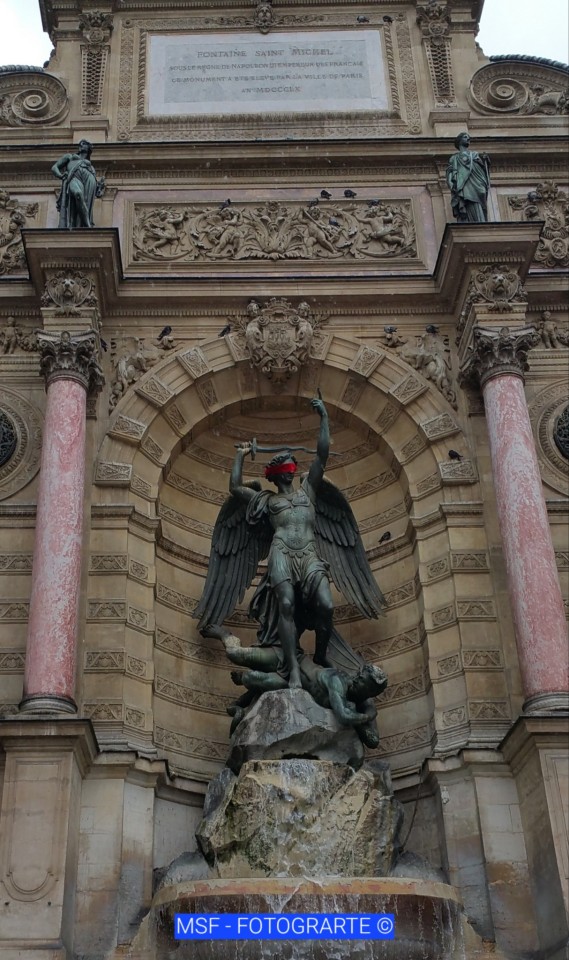
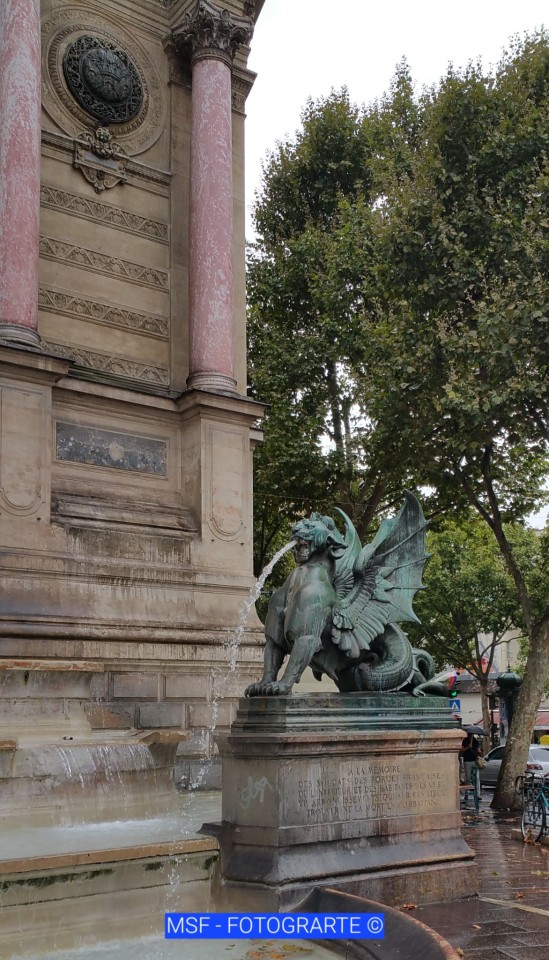

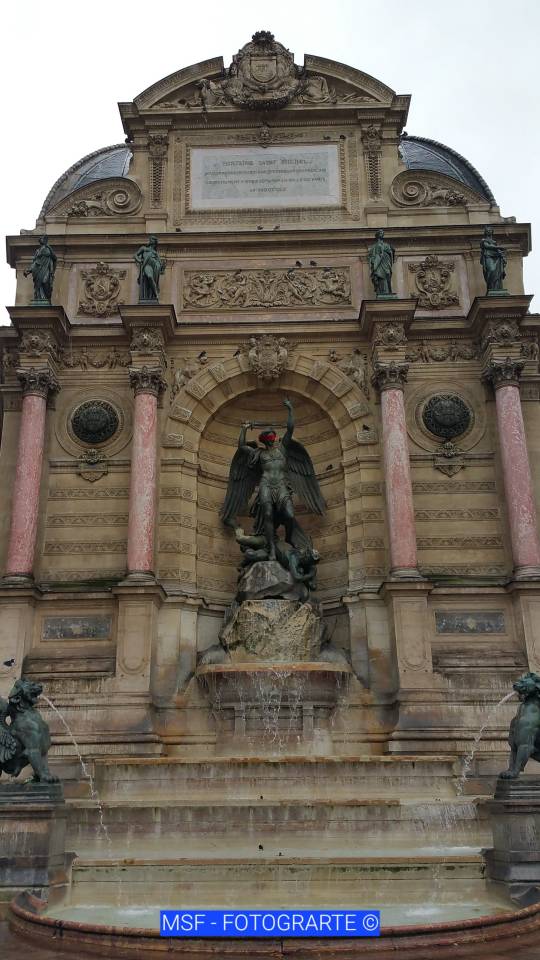
View On WordPress
#Barón Haussmann#Davioud#Francisque-Joseph Duret#Fuente de San Miguel#Fuentes#Fuentes y jardines#Napoleón III#París#San Miguel venciendo al demonio#Siglo XIX
1 note
·
View note
Text
Merci Brigitte Leloire Kerackian pour cette interview diffusée sur Radio Arménie de Lyon, ma toute première interview 😊 (sans grande grande préparation 😊😊 dans une brasserie parisienne)
L’occasion de parler de l’art de la miniature et de l’exposition collective « La Miniature Persane au Jardin du Luxembourg » avec l’association « Abbas Moayeri Héritage Art & Culture », au Pavillon Davioud dans le Jardin du Luxembourg
24 août - 4 septembre 2023
Entrée porte Vavin: 55bis, rue d’Assas
75006 Paris
#miniatures persanes#Abbas moayeri#exposition parisienne#French exhibition#parisian exhibition#indopersian miniature painting#laureen topalian#radio arménie#radio arménie Lyon#jardin du luxembourg#pavillon Davioud
2 notes
·
View notes
Text
The Charivari Awards of 1862


I started translating this because there’s one joke about Les Misérables but ended up translating the whole thing because, like my fav chapter 1817, this gives a little peak into 1862.
Source: Le Charivari, 26 August 1862
The distribution of prizes has been finished for many days in all the secondary schools, and the Charivari has not yet given out its annual awards to those who merit it the most.
It is but a little slip that we are hurrying to fix.
In fact we are distributing those prizes today; better late than never.
No useless speeches and let's cut to the chase!
French Language Prize
First prize to Victor Hugo for his masterpiece Les Misérables.
A bishop (whispering to his neighbor): Well, what do you think?
2nd bishop: It’s horrible.
3rd bishop: It’s vile! Anyone could write les Misérables, but no one is capable of writing petitions like those we issued on our return from Rome.
Architecture
This year we are not awarding a prize for architecture, we are waiting for the great opera house to be finished. [The foundation of the Opera Garnier had been poured that January but the experienced problems due to lots of groundwater as Phantom of the Opera buffs will know]
M. Davioud [collaborator of Haussmann during the second empire] (to the side): Good heavens! And here I imagined taking home first prize. I am horribly vexed. What upsets me the most is that I made all my friends and acquaintances come to applaud for me.
Painting
First prize goes to Mlle. X…, celebrity of the underworld [I am guessing this is a reference to Mademoiselle V...by Manet but could be wrong]
All the dandies: Bravo Mlle. X…bravo!
Mlle. X… is not present for the call, the prize is put to the side and will be sent by a delegate.
Music
Honorable prize to M. Felicien David for his opera of Lalla-Roukh. [It was the hit opera of 1862 apparently]
Big Box/Bass Drum [I am so confused by this one. The title is Gross Caisse if that means anything to anyone]
First prize… Here the embarrassment of the examiners was very strong. Indeed, to whom should this first prize be awarded? because forty three general stores [magasins de nouveautés, a precursor to the department store] earned it.
This rivalry proves that our generation is quite a nice force on this noisy instrument. Therefore we have decided to share this award.
First prize goes to a general store that gave a discount of 105 fr. due to change of owner.
Second prize to a tailor who for 13 francs gives out a frock coat and a ticket to see the sea by pleasure train.
Third place goes to to Mlle B****, an actress, who sold her furniture to get people talking about her.
Arithmetic
First prize to numerous restauranteurs for their talent at making large additions.
Second prize to M. Z…speculator, vert adept in subtraction.
Certificate of merit to the sultan, very strong in retaining things–when it comes to paying his troupes. [any guesses who this is referring to? Is it Napoleon III? Does this have to do with the colonization of Algeria? I am really lost]
Second certificate of merit to the Americans of the north and the south who have much disposition for division.
Geometry
Prize of honor to Mlle Theresa, a young doe who is iron clad in that science.
She knows that for a young man the shortest route to get to Clichy is to pass by her. [?]
Chemistry
A unique prize goes to the political writer Three-Stars who, without any preparation, knows how to make a paper turn all colors from white to blue to red. [les Trois-Etoiles was a pseudonym of English journalist Eustace Clare Grenville Murray though I don’t quite no the sandal maybe the answer could be found in here]
An assistant: In chemistry terms that is called precipitating [also means rushing], isn’t it?
The neighbor: Yes
The assistant: Precipitating so much could end with his breaking his neck.
The neighbor: That’s his problem. Why is he ambitious and desiring to win first prize?
Perseverance
Prize of honor to Russia. Never has a nation better persisted in refusing all the concessions that are asked of Poland.
Manners
First prize to Austria that washes everything it has to pay its debts.
Consolation prize
As the custom is to give a consolation prize to those who didn’t win anything, we will follow the custom.
First prize to Poland for continuing to be patient.
Second prize to M. Vulture, store owner, who decreased by 35 francs a rent of 6 thousand francs. We must encourage him.
Ladies and gentlemen, the awards are over. We hope we’ve upset less people than the Conservatory.
13 notes
·
View notes
Text

.
Thursday Throwback... Kiosque a Journaux (Newsstands)
We owed the newsstands to Baron Haussmann (who was also in charge of transforming the old medieval Paris into what we know today as the "Haussmannian" buildings built along the wide avenues opening up Paris). French architect Gabriel Davioud was commissioned to design small, elegant pavilions. It was on the Grands Boulevards that the first kiosk was built (on August 15, 1857), responding to the desire to gentrify one of Paris's greatest boulevard. In a minor revolution, the new kiosks, equipped with a lighting system, now lit up the public boulevards at night! But just two years later, these pretty, innovative designs were replaced by others deemed even more beautiful. By 1859, the new Parisian kiosks were even more imposing: taller, they were surrounded by friezes and topped by domes of zinc scales and a spire. By the end of the 19th century, the style and practicality of these kiosks, with their awning and display, gradually increased to 340 by the 1880s.
Today, there are around 360 newsagents in Paris, slightly more than in 1880. But it hasn't always been easy. In 2004, for example, there were just 266 newsagents left in the capital, as newsagents went bankrupt or abandoned a business deemed too difficult and unprofitable. To stem this loss, Paris City Council decided to give newsagents a break on the licence fee they had been paying up until then, before authorizing them to diversify their products at the end of 2011, with a single requirement for newsagents: that the press represent at least 2/3 of their business.

News-stands have almost all changed their appearance since 2018, as Paris City Hall launched a major operation to replace the classic model with brand-new, sleeker and more modern ones, a shelter made of recyclable metal, aluminum and glass, whose glass façade lets in natural light and is inspired by artists' studios and Parisian rooftops. (Source)
NB: The last 4 remaining Kiosk Type 1900 (all converted to Flower shops) can be found: place d'Estienne d'Orves (9th), 21 avenue du général Sarrail (16th), 30 avenue Corentin Cariou (19th) and 6 boulevard de Charonne (20th)
#CelineIsNotAnExpatAnymore#France life#Paris#kiosque a journaux#newsstand#CelineThrowbackThursdayInParis
4 notes
·
View notes
Text
Paris Art History May Term: Final Exam Reflection
Group members: Skylar DeWitt, Rachel Douma, Lauren Carpenter, and Bryn Couturier
Temple of Sibyl (19e)
As our first stop on our scavenger hunt final, this beautiful park and monument was a great way to start! At first glance, we were all stunned by the beauty of the temple sitting atop its rocky outlook. Upon further inspection, we discussed questions such as whether or not the rock formations were natural, and when the monument was made. After doing some research I was able to find out that the rock formations it sits on are actually man-made, and that the temple itself was designed and completed by the architect Gabriel Davioud in the late 19th century. Witnessing it today we were able to observe Parisians engaging in a multitude of Saturday leisure activities from walking their adorable dogs to exercising along the water’s edge. Even though the two walking bridges to access the island were closed, this was an amazing stop to relax and take in the nature-filled space that seemingly transports you away from the hustle and bustle of the city.

Passerelle Richerand pedestrian bridge (10e)
When walking up to this cast iron walking bridge, we noted the beauty of the view of the canal from the top. Now decorated with an assortment of what could be argued as graffiti or street art, this bridge stands as a reminder of the canal itself. Build in the early 19th century by Napoleon I, this canal was one of the first planned waterways to bring drinking water to the city of Paris. Now still connected to the seine river through ports, this calm river is a popular spot for a shady river walk or view of the neighborhood.

The foundation of the Bastille in the Bastille Metro Station (11e)
Upon stopping at the Bastille Metro Station, we found ourselves face-to-face with a moment of preserved history! History is not something I have found myself expecting to find when scanning my Navi-go and entering the Paris metro station, but this example of a memorable historic site changed my expectations entirely. Discovered during the expansion of line 5 on December 17th, 1906. As we saw in the Bastille station on line 5, it has since been marked off and preserved within the new Metro addition. Marked not only by its historic stone appearance and protective glass covering, the city of Paris has added plaques and information signs to help inform anyone from the daily passerby or visiting tourists of its history and importance. Having learned about the extensive, and at some points, destructive history of the Bastille, we all found it amazing to witness the original foundation and wonder about its distance below modern-day ground.

https://www.travelfranceonline.com/bastille-metro-station-platforms-murals/#:~:text=Bastille%20Metro%20station%20was%20inaugurated,order%20to%20highlight%20its%20layout.
La Madeleine (8e)
Travelling to the 8th Arrondissement, we stopped at the Église de la Madeleine, or, La Madeleine. With construction beginning under King Louis XV, La Madeleine bears the traditional features of a Greek temple, like a frieze and a columned entrance, distinguishing itself from the surrounding Haussmann buildings. With 52 Corinthian-style columns lining the building and the frieze depicting the Last Judgement, overlooking the city, the Madeleine is best known for its sheer size and unique, neoclassical style. Today, the Madeleine still serves as a Catholic parish church, as was orignially intended, and is the focal point of Rue Royal; however, due to construction, we were unable to get a full view of the front of the building. Currently, scaffolding covers large swaths of the columns, and the stairs are largely blocked off to pedestrians. Because of this construction, we unfortunately could not take in the full splendor of the Madeleine, but we were still able to enjoy the frieze and the columned side view of the building, and note how the art and architecture periods we have studied parallel each other.

“Église de La Madeleine - Paris Tourist Office.” Paris Convention and Visitors Bureau. https://en.parisinfo.com/paris-museum-monument/71158/Eglise-de-la-Madeleine
“Eglise de la Madeleine Visitor Guide.” France This Way. https://www.francethisway.com/paris/eglise-de-la-madeleine.php
Century-old rats in the window of Julien Aurouze and Co. (1er)
Julien Aurouze and Co. showcases a surprising collection in its storefront windows… From a distance, the shop appears charming with its painted green exterior. Yet, upon closer inspection, our group discovered the macabre sight of rat carcasses hanging inside. Although we found it disturbing, we were captivated by the remarkable preservation of these bodies spanning a hundred years. Upon research into the history of Julien Aurouze and Co., we found that it has served as a pest control shop since the 19th century (Mishmash, 2016) Fun fact: it has even been included in the Pixar movie ratatouille! While it wouldn’t be #1 on our list of places to visit in Paris, it was quite an interesting site to see.

Citation:
Mishmash, U. (2016, August 1). Unusual Shop Fronts: Julien Aurouze & Co., Paris | Urban Mishmash. Urban Mishmash | Paris. https://www.urbanmishmash.com/paris/city-guide/shops/julien-aurouze-co-unusual-shop-front/
Street sign on rue Jean-Jacques Rousseau (1er)
In the first arrondissement is the rather unassuming street “Jean-Jacques Rousseau.” The street was named after the philosopher, writer, and musician Jean-Jacques Rousseau (1712-1778). Rousseau lived on this street during the height of the enlightenment who believed that human beings are inherently good and only become bad when corrupted by society. Therefore, he believed that society should function based on the general will of the people and thus led to Rousseau being one of the first to argue for the sovereignty of the people. Rousseau’s philosophy was instrumental in the development of ideas that would culminate in the 1789 revolution and continue to influence French politics to the present day. The apartment where Rousseau lived with his wife still stands on Rue Jean-Jaques Rousseau and serves as a reminder to the ideas that freed the French from the monarchy and allowed them to develop a government that supports its people above all else.

Citations:
“Jean-Jacques Rousseau.” Wikipedia, May 13, 2023. https://fr.wikipedia.org/wiki/Jean-Jacques_Rousseau.
“Rue Jean-Jacques-Rousseau (Paris).” Wikipedia, April 9, 2023. https://fr.wikipedia.org/wiki/Rue_Jean-Jacques-Rousseau_(Paris).
Grave of Jean-Paul Sartre and Simone de Beauvior in Montparnasse Cemetery (6e)
In the Montparnasse Cemetery lies the grave of Simone de Beauvoir and her life partner Jean-Paul Sarte. Simone de Beauvoir was a French existentialist philosopher and writer who was instrumental in the early feminist movement in France. Her partner Jean-Paul Sartre was also a philosopher and the pair both read and influenced each other's works. Beauvoir and Sartre never married or had children but remained life-partners until his death in 1950. Sarte’s existentialist philosophy helped shape both academic and public thought during the 1900’s and 50,000 people visited his grave after his death. Simone de Beauvoir’s work was fundamental in the progression of feminist thought. Both Beauvoir and Sartre influenced philosophical thought both throughout France and in the rest of the world.

Citations:
“Jean-Paul Sartre.” Wikipedia, May 24, 2023. https://en.wikipedia.org/wiki/Jean-Paul_Sartre#Career_as_public_intellectual.
“Simone de Beauvoir.” Wikipedia, May 25, 2023. https://en.wikipedia.org/wiki/Simone_de_Beauvoir.
The ruins of the Roman baths at the Musée de Cluny (5e)
In the 5th Arrondissement of Paris, large Roman ruins seem out of place, yet, the Haussmann buildings and tall trees surround the expansive remains of a Roman bathouse. Now a part of the Musee de Cluny, these first or second century ruins span 6000 square meters and are what is left of an ancient frigidarium, the cold room of a bathouse. With tall ceilings visible from the street, but the “ground level” now being underground, these ruins are a unique Parisian landmark. As some of us had all already visited the Musee de Cluny earlier this week, we appreciated the opportunity to view the ruins from the exterior, something we did not do upon our first visit. We noted how, from the street, the ruins do not look as expansive as they are from the inside, and remarked how different and unassuming the exterior looks. On the street surrounding the Cluny, a market was bustling. Booths lined the sidewalks, selling normal market goods in a spread out setting; we wanted to stop at a macaron booth that we stopped at on our first visit to the Cluny, but had to rush to our next location.
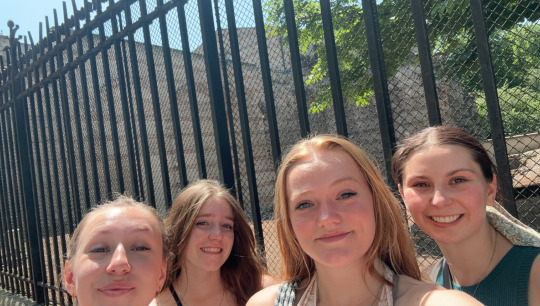
“The Ancient Thermal Baths.” Musée de Cluny: Le Monde Médiéval. https://www.musee-moyenage.fr/en/site/the-ancient-thermae.html
The exterior facade of St-Étienne-duMont church (5e)
As we approached St-Étienne-du-Mont church, our group was greeted with a delightful surprise – the captivating beauty of the cathedral. Positioned in the heart of Place Sainte-Geneviève, it exudes an imposing grandeur that dominates the surrounding area. Numerous individuals were scattered about, amidst the presence of rectangular stones placed around the vicinity. The architectural design seamlessly blends gothic and renaissance influences, featuring a stunning gothic rose window and flying buttresses. Although we regretted not having the opportunity to explore its interior, the sheer loveliness of the exterior was a sight to behold.

0 notes
Text

The Saint-Michel Fountain is a fountain designed by Gabriel Davioud and inaugurated in 1860 in the 6th arrondissement of Paris on Place Saint-Michel, at the intersection of Boulevard Saint-Michel and Rue Danton. ✝️
0 notes
Video
Pavillon Davioud by Pekka Nikrus
#chair#building#traffic cone#safety stripe tape#red#white#jardin du luxembourg#luxembourg gardens#pabellón#travel#paris#france#europe#pni#pekka nikrus#skrubu#flickr
0 notes
Photo

Fontaine en bronze les quatre parties du monde dessinée par Carpeaux et exécutée par Davioud : Hommage a Marco Polo et Robert Cavelier de la Salle. #jardinsdesgrandsexplorateurs #fontaineenbronze #lesquatrepartiesdumonde #carpeaux #davioud #marcopolo #robertcavelierdelasalle #mairiedeparis #instapic #photooftheday #parismaville (à Jardin des grands explorateurs : Marco Polo et Cavelier-de-la-Salle) https://www.instagram.com/p/B6VYt3NigKL/?igshid=sepjncipqo4j
#jardinsdesgrandsexplorateurs#fontaineenbronze#lesquatrepartiesdumonde#carpeaux#davioud#marcopolo#robertcavelierdelasalle#mairiedeparis#instapic#photooftheday#parismaville
0 notes
Text
Le Théâtre du Rond-Point

Le Rond-Point des Champs-Elysées ponctue le cheminement d'un piéton les remontant, en un contournement circulaire. Au sud de celui-ci, au sein de l'ancien Carré des Jeux des Jardins des Champs, se trouve le bien nommé Théâtre du Rond-Point.
Tout comme le Théâtre Marigny proche, il s'agissait à l'origine d'un panorama, structure immersive plongeant les visiteurs au centre d'une peinture panoramique se développant tout autour d'eux sur 360°, d'où sa forme de rotonde. En 1839, l'architecte Jacques Ignace Hittorff édifie en ce lieu un premier panorama en rotonde, qui se retrouvera intégré aux bâtiments constituant l'Exposition Universelle de 1855, avant d’être détruit l'année suivante. C'est en 1860 qu'est élevé le bâtiment actuel, par le grand architecte du Second Empire Gabriel Davioud, prenant pour nom le Panorama National. La Rotonde du Panorama abrita de 1893 à 1980 une patinoire célèbre, Le Palais de Glace. Il fallut attendre 1981 pour que cette rotonde se transforme en théâtre, avec l'arrivée de la compagnie Renaud-Barrault et leur structure mobile en provenance de l'éphémère théâtre d'Orsay, en l'ancienne gare d'Orsay, où de grands travaux s'amorcent alors pour y instaurer un musée national... Jean-Louis Barrault et Madeleine Renaud inaugurent ce nouveau théâtre avec un spectacle qui fera date: L'amour de l'amour. S'y alternent durant la décennie suivante pièces contemporaines et spectacles extrême-orientaux, jusqu'à sa reprise par une association dirigée par Robert Abirached, qui charge l'architecte Jean-Michel Wilmotte de réaménager les lieux, les divisant en une grande et une petite salle, créant à cette occasion un espace d'exposition, une librairie et un restaurant donnant sur l'extérieur (comme à Marigny). En 1995, le nouveau directeur Marcel Maréchal remodèle la grande salle (d'une capacité de 760 places), prenant en hommage le nom de Renaud-Barrault. Le Théâtre du Rond-Point est dirigé depuis maintenant vingt ans par le metteur-en-scène Jean-Michel Ribes, dont le cheval de bataille est d'encourager la création contemporaine, ne produisant et diffusant que des spectacles d'artistes vivants, avec une communication originale par le biais d'affiches illustrées depuis 2004 par le dessinateur de BD Stéphane Trapier.

L'ancienne entrée du théâtre, côté jardin, présente encore son portique d'origine, aux colonnes corinthiennes surmontées d'un fronton rappelant la vocation première de la rotonde, avec un programme pérennisé pour l'éternité, de représentations des grandes batailles napoléoniennes.
Crédits : ALM’s
#monument#architecture#culture#théâtre#rond-point#champs-élysées#jardin#panorama#patinoire#renaud-barrault#robert abirached#jean-michel wilmotte#jacques ignace hittorff#gabriel davioud#exposition universelle#rotonde#jean-michel ribes#stéphane trapier#portique#colonnes#fronton#paris#8ème#photography#photooftheday#dessins#affiches
5 notes
·
View notes
Text

#paris#quartier latin#personal#saint michel#fontaine#fountain#saint michel fountain#sculpture#architecture#parisian#parisian architecture#eclecticism#eclectic architecture#gabriel davioud#19th century
8 notes
·
View notes
Photo



"Kiosque de l'Empereur" construit à la demande de Napoléon III par l'architecte Gabriel Davioud (1852) sur l'île du "Lac Inférieur" du Bois de Boulogne, juillet 2021.
2 notes
·
View notes
Photo

We’ve all been made aware of how important it is to save the bees, and I can’t think of anything more wonderful than going to the little beekeeping school of Paris, the Rucher du Luxembourg

Nearly a million bees are in the seventeen hives of the Rucher du Luxembourg (rucher meaning apiary).They produce about 450 pounds of honey, which are sold every Autumn at the Orangerie du Luxembourg, just a few minutes up the garden path.
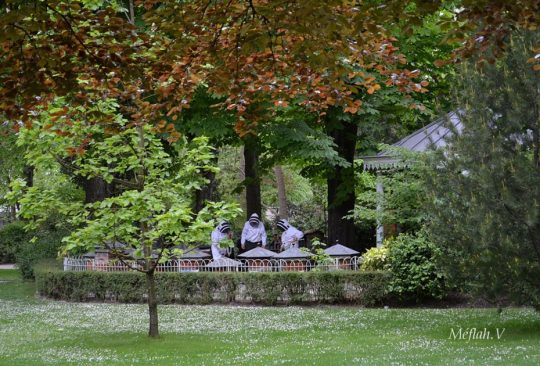
The 19th century pavilion is a charming site particularly when the beekeepers are out tending to the apiary.

The first beekeeping school in Paris began with the creation of the Beekeeping Society back in 1856, founded by a librarian and teacher named Henri Hamet.

The apiary briefly disappeared in 1866 but was restored in 1872 and ever since, training in modern beekeeping techniques have continued.
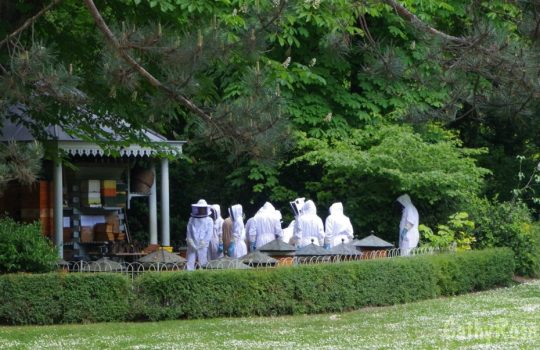
Courses introduce students to the complex and magical world of beekeeping, and meet every Saturday morning from mid Feb. to Sept. with breaks in July and Aug.

Students begin learning theory inside the 19th century Pavillon Davioud (pictured above) and then move on to the apiary and practicing their skills with the hives. A final exam earns an official beekeeping degree & permit.
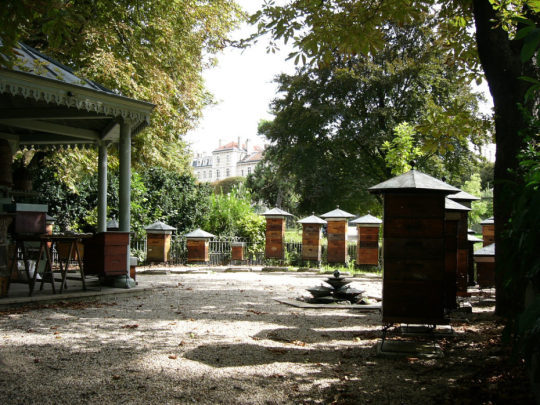
Of course, students have to speak a little French. (Finally, all my years of it would pay off.)

Since more people are keeping bees, Parisians are asked to let the local police headquarters know.

What a beautiful place to learn.

You can visit the beautiful gardens- A ticket is about 13€ ($13), 9€ ($9) for visitors between 16 and 25 years old, and free under 16 years old.
https://www.messynessychic.com/
267 notes
·
View notes
Text
instagram
Je suis très heureuse de participer à l’exposition collective « La Miniature Persane au Jardin du Luxembourg », qui sera aussi l’inauguration de l’Association « Abbas Moayeri Héritage Art & Culture »
24 août - 4 septembre 2023
Tous les jours-Entrée libre
Pavillon Davioud, Jardin du Luxembourg
Entrée Porte Vavin: 55 bis, rue d’Assas
75006 Paris
#abbasmoayeri#abbasmoayeriheritageartetcylture#miniaturepersanecontemporaine#miniaturepersane#persianminiature#indopersianminiature#Instagram#laureen topalian#exposition parisienne#French exhibition
1 note
·
View note
Text



Paris - Latin Quarter: Place St-Michel - La Fontaine Saint-Michel
La Fontaine Saint-Michel (Saint Michael Fountain) was built in 1860 by French architect Davioud. The fountain's centerpiece is a bronze sculpture by Duret, inspired by a Raphaël painting in the Louvre, depicting St. Michel (St. Michael) slaying the devil over two watching dragons.
9 notes
·
View notes
Text
Chrysanthemum Pergola pt.01
Following a non-causal compositional principle, I walk by myself at the Latin Quarter, then at the Saint-Michel fountain, then at the Sorbonne square and finally at the leafy Luxembourg Gardens: the Orangerie and the Pavillon Davioud. The distance between you and me has eventually filled with sunny flower-shaped dots.

View On WordPress
2 notes
·
View notes
